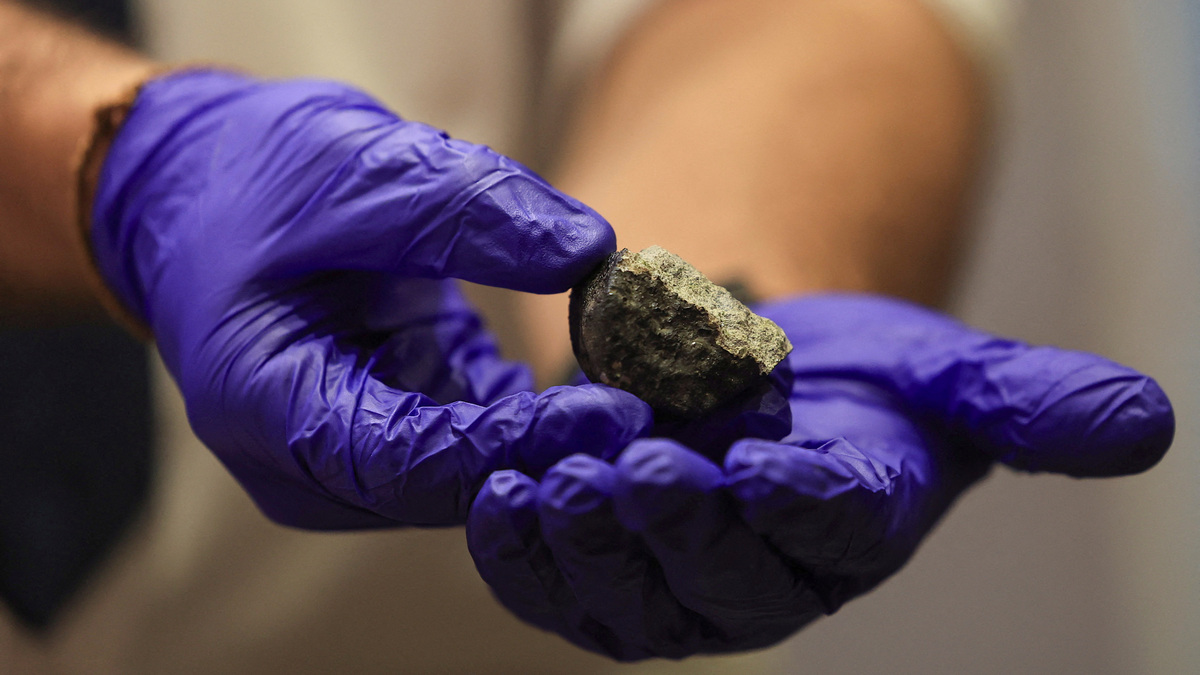On a Sunday morning in late August 2024 a nine-year-old girl named Eli-zé du Toit was sitting on her grandparents’ porch near a small town in South Africa’s Eastern Cape province, when she heard a long rumble, then heard a rustling in a nearby fig tree. As she watched, a rock fell out of the tree. When Eli-zé picked it up, she noticed that the rock had a black crust and a grey interior “like concrete”. It was warm on the crust and cold on the inside. Elsewhere in the Eastern Cape, videos and photographs on social media of a bright light in the sky tipped scientists off to the possibility that a meteorite had fallen in the area. A meteorite is a piece of rocky space debris that survives after colliding with the Earth. On 26 August, a day after the event, scientists confirmed that there was sufficient evidence to link the two events to a “likely car-sized” rock fragment having entered Earth’s atmosphere and disintegrated over the Eastern Cape.
The rock young Eli-zé found was just one small fragment of that meteorite, weighing in at about 90 grams. It was unveiled at a press conference involving scientists from Nelson Mandela University, Rhodes University as well as the University of the Witwatersrand, on 3 September. The Conversation Africa asked two of them, Roger Gibson and Deon van Niekerk, to explain the importance of the find.
How rare is this event?
In 2023 two meteorites found on a farm in the Northern Cape province became the country’s 50th and 51st to be formally recognised by the Meteoritical Society’s nomenclature committee, which adjudicates all new meteorite submissions from around the world.
Once this specimen has gone through that process it’ll become 52 on the country’s list.
There are just over 75,000 meteorites in the society’s database – about half of those come from Antarctica , with the Sahara second. The individual events by which most of these meteorites fell to Earth are unknown and even their locations may not be exactly known in the case of the Saharan stones, which are picked up by nomadic people. That means crucial information is lost to scientists.
Read more: Meteorite discovery: unusual finds by South African farmer add to space rock heritage
South Africa probably has a lot more meteorites that haven’t been identified as such because they don’t stand out where they’ve landed or don’t look unusual enough for people to examine them.
Impact Shorts
More ShortsMeteorites are pieces of our solar system which fall to Earth, where they can be studied without having to send expensive probes up into space to examine them at the source. They contain a wealth of information about the origins of our solar system and the rocky bodies in it, helping us to understand their, and even Earth’s, origin and evolution.
Types of meteorites
There are different types of meteorites.
The most common are chondrites – they make up about 86 per cent of all meteorites that have been found globally. They are the oldest solid objects in the solar system , formed around 4.57 billion years ago. Scientists have a particular interest in carbonaceous chondrites; as the name suggests, they contain carbon and several space probes have been deployed recently to bring back samples of this type from space, so they can be studied as a possible key element for the building blocks of life on Earth.
Slightly more than half of the remaining meteorites that have been found on Earth are achondrites , with the rest being irons. The most recent South African meteorites found before this one were both chrondrites, while one found in Botswana in 2018 was an achondrite.
Read more: Rare meteorite recovery in Botswana can help reveal secrets of outer space
This newest find is what’s known as an achondrite breccia. The outside is, as Eli-zé du Toit noted when she picked it up, black; inside there’s a light grey matrix in which we can see fragments (some millimetres long, others centimetres) that we think are broken pieces of mineral grains and other types of rock.
Where did it come from?
It’s likely to have come from one of the larger bodies in the asteroid belt , which is between Jupiter and Mars. After repeated impacts onto that body, one impact will have shot this piece off and sent it on a trajectory towards Earth.
We can’t yet say if that happened tens of millions of years ago or thousands of millions of years ago.
From what we can see, and comparing it with what we know from other samples around the world, the meteorite looks like it’s part of an achondrite sub-group known as HED (howardite–eucrite–diogenite). Rocks that are part of this sub-group have been found all over the world and, through study, scientists realised that they had several similarities. This led to the hypothesis that HED achrondrites – including ours – all come from the asteroid 4 Vesta . It is the second most massive object in the asteroid belt, spanning several hundred kilometres across.
What should you do if you find a meteorite?
If you see what you think is a meteorite – a rock that’s appeared on your lawn that looks out of place, or perhaps one you’ve spotted in the gutters of your house – we ask that you please take a photograph and send it to us. You’re looking for a rock with a black fusion crust and a light grey inside, perhaps speckled with green. We’ve set up an email address for those alerts and for any other eyewitness accounts: meteorites.science@wits.ac.za. Alternatively contact epma@ru.ac.za.
We’ve already been blown away by the public response and how much people want to help.
This article is republished from The Conversation under a Creative Commons license. Read the original article .
)